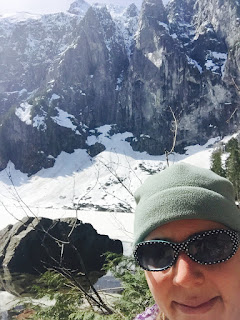Recently, a colleague and friend decided to go on a trip to New York. While he was there, he made a post on Facebook about the reasons music majors choose to perform or teach. Since that post, I've been rolling over in my head why it is some people are drawn to teach and some are drawn to perform.
On a basic level, there is some practicality to it. Some people know they don't practice enough, too much competition for their instrument, don't want to deal with the financial realities of freelancing, etc. But we all know music teachers who are legitimately good enough to perform professionally (and many do, when the schedule allows it). So that's not all it. And those of us in the profession certainly know music teachers who chose that practical route without realizing the reality of teaching and all the politics and struggle---and they either become cynical and bitter or they burn out and quit.
The only conclusion then is that, for the majority of music teachers and performers, there is something more going on. A more subtle pull one direction or the other. And while I was out in my garden this afternoon cutting herbs and pulling vegetables for dinner I think I may have stumbled upon it. *sidenote* I may also have to give credit to a random tweet by Dr. Mitchell Robinson asking about the appeal of Blue Apron....
For performers, rehearsing and learning are a necessary tool to get the product they are aiming for. They may love or hate it, but in essence it is just part of what makes performing "work."
For teachers, we absolutely revel in the process of learning. It's what gets us out of bed in the morning (or keeps us up late at night). And I think that distinction specifically, is one of the reasons that performers who go to teach are often not totally satisfied with their career choice.
Going back to my garden to clarify. We moved into a new house this year. The soil in this neighborhood is quite different from anything I've ever put a garden in. So I made deliberate choices based on my prior knowledge to see how successful I could be. Seattle doesn't get that warm in the summer, so I chose a spot for my tomato plants up against the house facing west, where they not only get the warm afternoon sun for several hours, but also the extra heat coming off the house. In the Willamette Valley, I had trouble growing root vegetables because of maggots and slugs, in part because the riverbed soil holds a lot of water. The easily drained sandy soil I have now requires me to water more often, but I've had zero soil pests. So I planted carrots and grew them successfully with no trouble at all!
The point is that I don't get satisfaction just from the finished product (although that soup smells pretty amazing right now) but also from watching and experiencing the process. Think of this in terms of teaching. You plant a seed deliberately in a specific place in the soil. Maybe you put too many seeds in that spot. So you thin the seedlings out. Fertilize. Water. Protect from pests that might destroy the plant. Fertilize and water some more, until the plant is big enough to grow on its own. Maybe bolt and go to seed and replant itself! Find out where things have gone wrong, maybe the spinach was in a spot that got too hot and when you replant, you choose a different place in the soil. Is this not also how good teaching works? Plant, feed,
But the analogy follows that factory teaching, like factory farming, may give us more quantity of the product, but not better quality. Tomatoes grown in sand in Florida for McDonalds don't taste as good as the vine-ripened beefsteak in your own yard. Diversity prevents pests. Planting too close together keeps the roots from getting deep enough, and often stunts their growth. But the point is that the successful gardener not only knows how to correct these problems, but is always looking for the better way to improve yield, and enjoys watching other people go through the process.
And now, if you'll excuse me, I have some seafood chowder to eat.
Sunday, July 23, 2017
Tuesday, April 4, 2017
Spring Break
For most of our marriage, Tyson and I have not worked in the same school district. When we did, and our breaks lined up it was magical, and we were able to go on some pretty amazing adventures (Campbell River on Vancouver Island, Indiana Dunes, and Green Bay). But for the vast majority, we have never had spring break at the same time (oh for Oregon and the ENTIRE STATE having spring break the third or last week of March *together*....)
So two years ago, I decided since he was full time for the Army and we were paying for daycare anyway, I would go hiking by myself. The first time, I went with my friend Karla, and we headed to Silver Star Mountain in the Gifford Pinchot National Forest. Springtime hiking is always a crapshoot when you want to hike anywhere above 2000 feet elevation, you are bound to run into snow even when the weather is clear. On Silver Star, we ran into snowfall about two miles in. Too deep to see the trail, too much snow falling to see anything else. So we turned around. We think we were about half a mile from the "summit" but it was just too risky (and what's the point of hiking to a summit if you can't see anything?). Two days later, I did Dog Mountain on the Washington side of the Columbia River Gorge. No snow, but the wind was howling and when I got to the clearing less than half a mile from the top, the wind was so strong I got blown off the trail and decided to head back for cover under the trees to eat my lunch. Too many clouds for a good view anyway.
So two years ago, I decided since he was full time for the Army and we were paying for daycare anyway, I would go hiking by myself. The first time, I went with my friend Karla, and we headed to Silver Star Mountain in the Gifford Pinchot National Forest. Springtime hiking is always a crapshoot when you want to hike anywhere above 2000 feet elevation, you are bound to run into snow even when the weather is clear. On Silver Star, we ran into snowfall about two miles in. Too deep to see the trail, too much snow falling to see anything else. So we turned around. We think we were about half a mile from the "summit" but it was just too risky (and what's the point of hiking to a summit if you can't see anything?). Two days later, I did Dog Mountain on the Washington side of the Columbia River Gorge. No snow, but the wind was howling and when I got to the clearing less than half a mile from the top, the wind was so strong I got blown off the trail and decided to head back for cover under the trees to eat my lunch. Too many clouds for a good view anyway.
When they say "less difficult" they don't mean "easy"
So last year, knowing that I may not get any further into a decent hike than I did before, I chose a hike that was well below the snow line, and the weather cooperated for a beautiful hike. This time it worked out.
But as I ate my lunch at the lakeshore, I heard a roar and was reminded of why extra caution must be exercised when you hike in the spring.....an avalanche occurred (safely on the other side of the water). It was mesmerizing and a powerful reminder that I was not being too cautious when choosing all of my safety gear---making my pack a little on the heavy side---better to have it and not need it.
This year, I was skunked again, not by the weather, but by the Department of Natural Resources, who hadn't gotten around yet to clearing the road I needed open today. The gate I parked at to the trail head is 7.2 miles. Tyson and I have a rule about hiking alone...never stray from the plan unless it's to turn around and come home. He's been skunked out of a couple overnight backpacking trips because of this rule, but you never want to change your plan of where to hike if you can't tell anyone else you're going to change it. Because then if you DO get in trouble, no one knows where to look. So I decided to walk down the road and see if I could even get TO the trailhead in the time that I had.
This year, I was skunked again, not by the weather, but by the Department of Natural Resources, who hadn't gotten around yet to clearing the road I needed open today. The gate I parked at to the trail head is 7.2 miles. Tyson and I have a rule about hiking alone...never stray from the plan unless it's to turn around and come home. He's been skunked out of a couple overnight backpacking trips because of this rule, but you never want to change your plan of where to hike if you can't tell anyone else you're going to change it. Because then if you DO get in trouble, no one knows where to look. So I decided to walk down the road and see if I could even get TO the trailhead in the time that I had.
If you've never paid attention while driving on one of these gravel trails the Forest Service and BLM/DNR call "roads" the scenery is not really all that exciting, usually. They are designed to get to the destination with the least hassle, which is saying something when you're cutting switchbacks into a mountainside. In any case, I got bored about 4.5 miles in, despite the magnificent waterfalls flowing over granite, and sweeping views of the mountains around Spada Lake. Walking on a road vs. a trail is also very hard on the boots and feet, something I underestimated for the distance (ow).
Nevertheless, I plan on exploring Tiger Mountain sometime later this week, rain or no rain. Despite all the difficulties this time of year, the scenery of this region is just too good to leave alone when I have time off work.
Subscribe to:
Posts (Atom)




